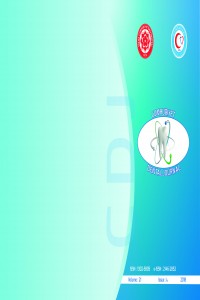Abstract
Objective: Computer-aided
design and manufacturing technology has shown great improvement in dentistry
since the 1980s. This technology is based on a one-stage restoration using
prefabricated blocks. Two main types of materials are used during CAD / CAM
indirect restorations: glass-ceramic /
ceramic and resin composite. CAD / CAM resin blocks are polymerized under high
temperature and pressure. Polymerization depth affects the surface hardness of
composite resins. When preparing a restoration, different depth layers of the
resin block are used. The aim of this study is to show that adequate
polymerization is achieved in each layer of the resin blocks and that the
hardness of each layer is the same. Two composite resin block materials and one
hybrid resin block material were included in this study.
Material and
method: The CAD/CAM block materials evaluated in this study were Cerasmart,
Lava and Vita Enamic Square specimens
(n=5/material) of approximate dimensions 10×10×2 mm blocks were sectioned (5
slices/block) from commercially available CAD-CAM materials using a diamond saw
(exakt 300 cl Apparatebau, Norderstedt, Germany) with water cooling. All
specimens were abraded followed by 500,1200,2500 grid using SiC abrasive paper
(exakt 400 cs Apparatebau, , Norderstedt, Germany). After storage in distilled
water at 37 °C for 24 hours the Knoop hardness test was performed using a
hardness testing machine (Buehler MMT 3 digital micro hardness tester, Lake
Bluff, IL, USA) using a load of 500 gf and a loading time of 10s.
Results: The
material with the highest hardness number was Vita Enamic block, whereas the
lowest numbered group was the Cerasmart. The rank order of surface hardness was
as follows: Vita Enamic> Lava Ultimate >Cerasmart.
Conclusion: The
hardness measurements of the layers of blocks were similar.
Keywords
References
- Ruse ND, Sadoun MJ. Resin-composite blocks for dental CAD/CAM applications. J Dent Res 2014; 93: 1232-1234.
- Awada A, Nathanson D. Mechanical properties of resin-ceramic CAD/CAM restorative materials. J Prosthet Dent 2015; 114: 587-593.
- Lebon N, Tapie L, Vennat E, Mawussi B. Influence of CAD/CAM tool and material on tool wear and roughness of dental prostheses after milling. J Prosthet Dent 2015; 114: 236-247.
- Tsitrou EA, Northeast SE, van Noort R. Brittleness index of machinable dental materials and its relation to the marginal chipping factor. J Dent 2007; 35: 897-902.
- Curtis AR, Shortall AC, Marquis PM, Palin WM. Water uptake and strength characteristics of a nanofilled resin-based composite. J Dent 2008; 36:188 -193.
- Stawarczyk B, Liebermann A, Eichberger M, Güth JF. Evaluation of mechanical and optical behavior of current esthetic dental restorative CAD/CAM composites. J Mech Behav Biomed Mater 2015; 55: 1-11.
Abstract
References
- Ruse ND, Sadoun MJ. Resin-composite blocks for dental CAD/CAM applications. J Dent Res 2014; 93: 1232-1234.
- Awada A, Nathanson D. Mechanical properties of resin-ceramic CAD/CAM restorative materials. J Prosthet Dent 2015; 114: 587-593.
- Lebon N, Tapie L, Vennat E, Mawussi B. Influence of CAD/CAM tool and material on tool wear and roughness of dental prostheses after milling. J Prosthet Dent 2015; 114: 236-247.
- Tsitrou EA, Northeast SE, van Noort R. Brittleness index of machinable dental materials and its relation to the marginal chipping factor. J Dent 2007; 35: 897-902.
- Curtis AR, Shortall AC, Marquis PM, Palin WM. Water uptake and strength characteristics of a nanofilled resin-based composite. J Dent 2008; 36:188 -193.
- Stawarczyk B, Liebermann A, Eichberger M, Güth JF. Evaluation of mechanical and optical behavior of current esthetic dental restorative CAD/CAM composites. J Mech Behav Biomed Mater 2015; 55: 1-11.
Details
| Primary Language | English |
|---|---|
| Subjects | Health Care Administration |
| Journal Section | Research Article |
| Authors | |
| Publication Date | December 30, 2018 |
| Submission Date | March 4, 2018 |
| Published in Issue | Year 2018 Volume: 21 Issue: 4 |
Cited By
Cumhuriyet Dental Journal (Cumhuriyet Dent J, CDJ) is the official publication of Cumhuriyet University Faculty of Dentistry. CDJ is an international journal dedicated to the latest advancement of dentistry. The aim of this journal is to provide a platform for scientists and academicians all over the world to promote, share, and discuss various new issues and developments in different areas of dentistry. First issue of the Journal of Cumhuriyet University Faculty of Dentistry was published in 1998. In 2010, journal's name was changed as Cumhuriyet Dental Journal. Journal’s publication language is English.
CDJ accepts articles in English. Submitting a paper to CDJ is free of charges. In addition, CDJ has not have article processing charges.
Frequency: Four times a year (March, June, September, and December)
IMPORTANT NOTICE
All users of Cumhuriyet Dental Journal should visit to their user's home page through the "https://dergipark.org.tr/tr/user" " or "https://dergipark.org.tr/en/user" links to update their incomplete information shown in blue or yellow warnings and update their e-mail addresses and information to the DergiPark system. Otherwise, the e-mails from the journal will not be seen or fall into the SPAM folder. Please fill in all missing part in the relevant field.
Please visit journal's AUTHOR GUIDELINE to see revised policy and submission rules to be held since 2020.

